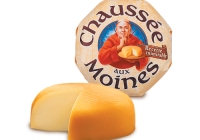
Chaussée aux Moines cheese - Made by Trappist monks the secret recipe is inimitable, more flavorful than a Saint-Paulin.

Chinese New Year 2025 or The Year of the Wood Snake
Element: Wood
On January 29th, we enter the Year of the Snake. The Snake is the sign of wisdom and maturity of mind. He is precise, calm, creative and possess logical, rational thinking. The origin of such an event dates back several millennia, throughout which legends rich in color and tradition have been woven.
New Year is undoubtedly the most important holiday for Chinese communities. Discover the significance of millennia-old traditions, part of a Chinese culture that has been passed down through countless generations. The origin of the celebrations dates back several millennia, during which time many legends, rich in color and tradition, have evolved.
One week before the new year, every Chinese family carries out a farewell ceremony. The genie of the hearth leaves the house on the final stroke of the old year and undertakes the long voyage to heaven in order to present his annual report to the Jade Emperor (the celestial god) concerning the family's good and evil deeds over the course of the previous year. In order to obtain the genie's favor, numerous gifts of food are offered to his image which is hung in the kitchen. The Chinese, logical and wise, offer him sweets, usually sticky ones, which will prevent him from opening his mouth and speaking ill of them before the Emperor.
The first day of the year is called "yuan dan"
yuan meaning "beginning" and dan, "daybreak." So the name refers not only to the first day of the year and the first day of the first month, but also to the beginning of the whole year, which is why this first day is also called "the three beginnings."
Red and noisy
The most enduring popular legend is certainly the one concerning Nien, a cruel voracious monster who, it used to be thought, devoured human beings on New Year's Eve. To keep him away, a strip of red paper on which a verse was written was hung on each side of the front door. Torches were lit and firecrackers set off all night long since Nien was thought to fear the color red, as well as light and noise.
Superstitions and Dragons
Chinese New Year, however, is not only a time of joy. There are also dangerous superstitions and taboos that have not completely lost their hold. It is still believed that one must not sweep the floor during the first five days of the lunar year, for fear of sweeping happiness and good luck out of the house. If you break a plate or dish, you say as quickly as possible "sui sui ping an," meaning "peace for the whole year," to banish bad luck. In other homes the use of knives or scissors is forbidden in case they should cut the thread of good fortune for the upcoming year.
Let's end on a happy note. There's no Chinese New Year without the dragon dance. Adorned in an array of shimmering colors, the dragon usually has 9 to 12 sections, each of which may be up to 3 meters long. Drums and gongs accompany the dance of this mythical animal so respected by the Chinese. May your year be happy and prosperous!
The festivities continue until the fifteenth day of the first lunar month.
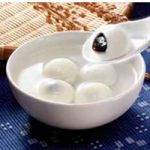
At New Year, as during all Chinese festivals, food plays an important role, far beyond mere sustenance. Most of the elaborate dishes are prepared for their symbolism and to bring good luck to the assembled guests. For example, garlic chives (chiu-tsai) represent eternity; turnips (tsai-tou) a good omen. "Long year" vegetables symbolize intelligence, etc. And there is also the importance of numbers: fish balls (yu-wan) and meatballs symbolize reunion. They are always presented in pairs. Fish, shrimp and meatballs, once linked to the top rankings in civil service competitions in ancient China, today represent success in studies. To ensure good luck throughout the year, the Chinese also give a special name to each dish. For example, a dish made up of five elements of the same kind (meat or vegetables) might be called "the five blessings of the new year," referring to longevity, riches, peace, wisdom and virtue.
There may be a multitude of dishes prepared for Chinese New Year's dinner. Custom dictates that there be as many dishes as there are guests, with the diners serving themselves to their taste.
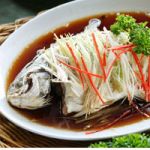
Don't cut up the whole fish, which represents abundance. Fish (yu) means "we have enough." A whole chicken represents health. Chicken must be presented with its head, tail and feet on to indicate accomplishment. Noodles must not be cut for fear of reducing one's life expectancy.

If you try "fa-kao," a kind of rice cake, look at the cracks - the wider they are, the more prosperous the new year will be, according to tradition.
Nian gao is originally from southern China. This sticky rice cake, steamed in lotus leaves, evokes a successful career and prosperity down the road. When eating these cakes, you are supposed to exchange wishes for a continually higher standard of living (it's a play on words based on the name of the cake which in Chinese is pronounced "gao," which also means "high," and "nian" (sticky) which also means "year."
In some regions, the first thing to be drunk at New Year is a cup of tea with lotus seeds, tea with sweet jujube served with watermelon seeds and sticky rice flour cakes. As you take a sip, you must say "tiantian mimi," meaning "life will be happy," and as you eat the cakes "bubu denggao," meaning "you will be promoted to a high position." Lotus seeds are also offered to married couples with the words "zaosheng guizi," or "you will soon give birth to a boy." The same day, filled sticky rice balls (tangyuan) are eaten for "tuantuan yuanyuan" so that all family members will be reunited and live in harmony.
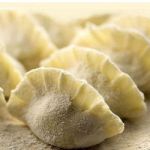
On New Year's Eve and New Year's Day, it is customary to eat dumplings, known as "jiaozi" in Chinese, which represent the progression of the years. They are filled and then boiled or steamed. In northern China they make "shui-chiao," shaping them like horseshoes, which is meant to bring riches to those who eat them. Plump half-moon shaped dumplings evoke "yuanbao," a 50 ounce silver ingot. Eating them is supposed to bring wealth and good luck.
Dumplings can contain a piece of sugar, a coin, a peanut or a chestnut, each signifying a different omen. Did you just bite into a sweet dumpling? Happiness will be knocking at your door. Did it contain a coin? Luck will smile on you. Is it stuffed with a chestnut? You'll soon have a boy. Is it filled with peanuts? That's a sign of longevity (in Chinese, peanuts are also called longevity fruit.)
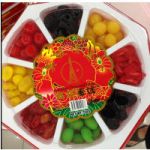
The box of candies that is traditionally given at New Years is round or octagonal and contains dazzling rows of candies to begin the New Year sweetly. These candies are given to friends and relatives during their visits. Custom dictates that once adults have taken a candy they place a red handkerchief in the middle compartment of the box. Each candied fruit is a sign of good luck:
- Melon: good growth and good health
- Red watermelon seeds: red symbolizes joy and happiness, truth and sincerity
- Lotus root: strong family ties
- Kumquat: prosperity. Kumquats are called "gam gat sue" in Chinese. The word "gam" is similar to the word for gold, and the word "gat" to that for luck. The tiny green leaves of this plant symbolize riches and the small fruits unity and perfection.
- Coconut: friendship
- Peanuts: longevity
- Longan: many good sons
- Lotus seeds: many children
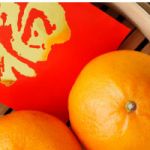
As in Western countries, New Year is a time to receive guests. Red paper banners are hung everywhere, inscribed with wishes for happiness, success, longevity or joy. On the afternoon of New Year's day and the following two days, families go out to visit family and friends and sometimes even superiors, to offer good wishes and to "be the guest." A few members of the family stay home to receive their own guests to whom they offer sweets, cakes, tea and tobacco. Offering sweets is a way of expressing a wish for a sweet life and a year without troubles. Children who arrive offering wishes for happiness receive an orange in return for their greetings. The orange symbolizes happiness and longevity. Giving this fruit to children signifies "many more years to come."
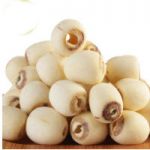
At New Year, families usually eat a vegetarian dish called "jai." Although this dish is made up only of roots and vegetables, the symbolism remains important:
- lotus seeds: represent an abundance of male offspring
- black seaweed: homonyms of abundance and wealth
- bamboo shoots: a term that sounds like "everything happens in the best of worlds"
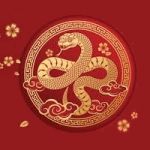
Part Two: The festivities continue until the fifteenth day of the first lunar month
Recipes
> Nian Gao with One Hundred Fruits - Sticky Rice Cake for new year
> Chinese longetivity noodle
> Click here for more Chinese Recipes

-

 Recipes
Recipes
-

 Products
Products
-

 Entertaining
Entertaining
-

 Chefs
Chefs
-

 Hints & Tips
Hints & Tips
-

 Glossaries
Glossaries








